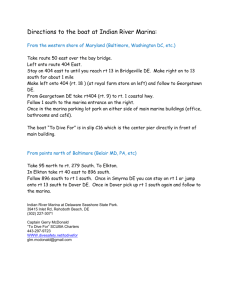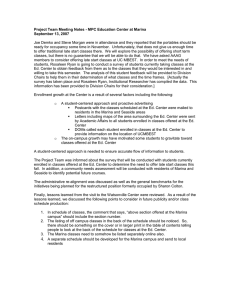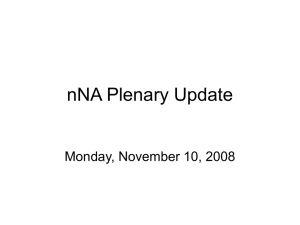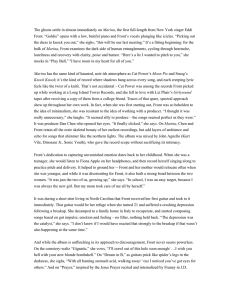ECO-TECH - Island Global Yachting
advertisement
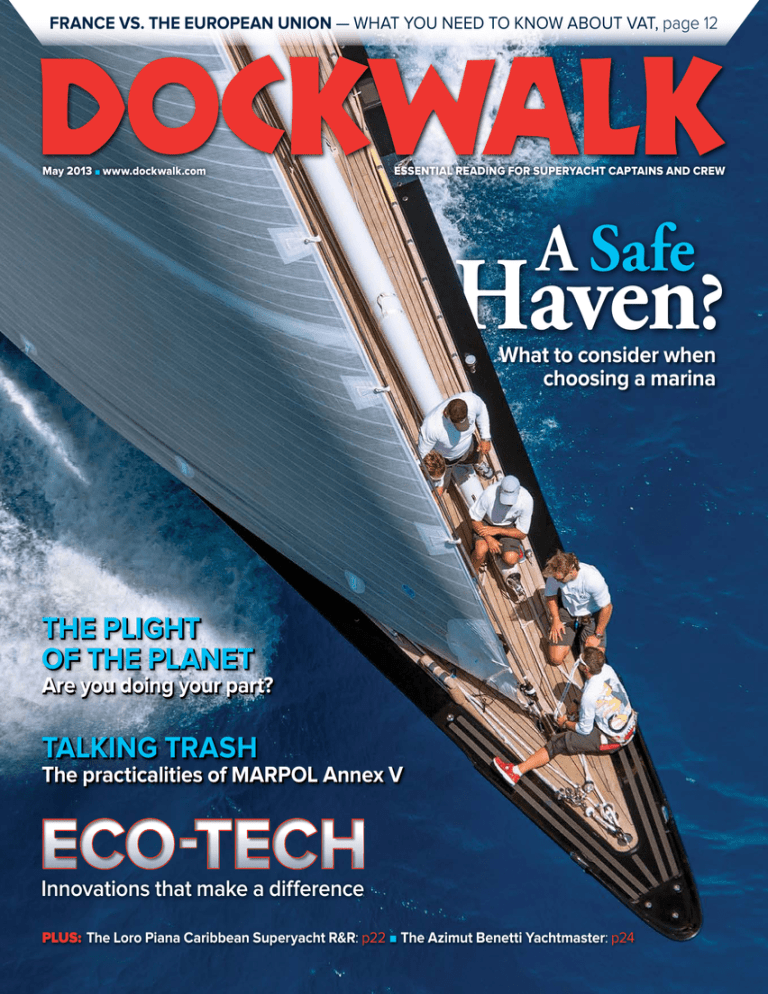
FRANCE VS. THE EUROPEAN UNION — WHAT YOU NEED TO KNOW ABOUT VAT, page 12 May 2013 ■ www.dockwalk.com ESSENTIAL READING FOR SUPERYACHT CAPTAINS AND CREW A Safe Haven? What to consider when choosing a marina THE PLIGHT OF THE PLANET Are you doing your part? TALKING TRASH The practicalities of MARPOL Annex V ECO-TECH Innovations that make a difference PLUS: The Loro Piana Caribbean Superyacht R&R: p22 ■ The Azimut Benetti Yachtmaster: p24 DOCKWALK.COM MAY 2013 28 A SAFE BERTH What to look for when you’re shopping superyacht marinas S uperyacht programs invest substantial money and training in keeping current with the maritime regulations governing safety at sea. But safety at the dock is an equal priority for most owners, captains and crew — and that can be more difficult to control. The good news is that today’s top superyacht marinas are striving to meet or exceed local, national and international fire, security and environmental standards to provide you and your yacht with a safe berth and peace of mind. West Palm Beach firefighters train at Rybovich marina and shipyard “Safety is a non-negotiable requirement in our business, and we spare no expense in ensuring the wellbeing of our guests, workforce and sub-contractors,” says Mario Byrne, marketing director for Rybovich marina and service yard in West Palm Beach, Florida. “It is a standard expected from a professional industry.” While all the marina staff members surveyed for this article made similar statements, before tying up in a new marina, it’s important for a yacht captain to learn as much as possible about the facility’s policies and procedures. Here’s a look at how some superyacht marinas are working to protect you — as well as the amenities they have added to attract and keep your business. © Gary Felton; courtesy of IGY Fire Yacht Haven Grande marina (bottom), St. Thomas, USVI 29 MAY 2013 DOCKWALK.COM Beyond hurricanes, which weather forecasters now can give us a fairly advanced and accurate heads-up, fire is perhaps the scariest threat to any yacht docked in a marina. Flames can spread quickly when boats are tied up near one another. A recent example occurred at the Portosole facility in Sanremo, Italy, last summer. According to news reports at the time, at 4 a.m. on August 29, a fire broke out aboard the 75-foot Pershing Ibris and soon engulfed its neighbor, Manhattan, a 79-foot Maiora. Manhattan was towed out of the marina in an effort to contain the blaze, but ultimately sank, as did Ibris at the dock. A similar incident took place in Grove Harbour Marina in Miami’s Coconut Grove district in December 2011, when a rapidly spreading fire caused severe to catastrophic damage to four yachts ranging up to 88 feet. Once again, a burning boat was towed away in order to stop the fire’s spread. In both cases, quick thinking by first responders effectively prevented more boats from catching fire as flaming vessels were separated from those as-yet unharmed. An article on recent yacht fires released by marine insurance company Pantaenius warns that the most dangerous fire is one that goes undetected: “Unmanned marinas or marinas without the required infrastructure play a part in the unfolding drama of a fire.” In addition to maintaining a vigilant crew presence aboard your yacht, it’s important to check on what Pantaenius terms “the required infrastructure” of a prospective marina in terms of fire preparedness. Here are some aspects to consider: ⊲ Dockside Equipment: At Westrec’s Sunrise Harbor Marina, a superyacht basin accommodating yachts up to 200 feet in Fort Lauderdale, all the docks have fire Courtesy of AIG Private Client Group By Louisa Beckett cabinets containing fire hoses and fire extinguishers within easy reach of the yachts berthed there, along with fire hydrants on the upland side of the marina. “The hoses need to be pressure-tested every five years and replaced if needed. Portable fire extinguishers are hydro-tested every year,” says Marina Manager Brad St. Coeur. In addition, he says, Sunrise Harbor has a portable fire pump that is tested every 30 days. “Everything else is inspected [by Broward County] once a year.” “Yacht Haven Grande Marina (YHG) is equipped with some nice emergency safety features like automatic fuel shut-off switches, a dedicated fire-fighting golf cart and nearly two dozen high-pressure freshwater fire hydrants located throughout the dock,” says Gili Wojnowich, general manager of the Island Global Yachting marina in St. Thomas, USVI, which berths yachts up to 450 feet. ⊲ Internal Training: Regular marina staff drills are as essential to fire prevention as maintaining the proper equipment. “Training your employees to detect, respond and clean up from these sorts of emergencies while focusing primarily on the life safety of others is crucial to being ready…,” says Wojnowich, adding, “Another important thing to keep in mind is that the majority of yacht crew around our facility retain an STCW’95 certificate…so along with our trained staff, there’s often a variety of resources available to assist in the event of an emergency.” “Our staff is trained yearly to prevent fires from expanding,” says Gabriel Ley, marina manager of Marina CostaBaja, which accommodates yachts up to 200 feet in La Paz, Mexico. “…Every drill, we find new ideas and feedback from the experience of new employees or a different trainer for these tasks.” DOCKWALK.COM MAY 2013 30 Paradise Village Marina Courtesy of Paradise Village Marina A Safe Berth ⊲ Training with Local Agencies: Many marinas take fire safety to a new level by training with local authorities and other first responders. Byrne reports that Rybovich not only complies with all fire safety codes and standards required by state and local authorities, but it also partners with local fire departments to implement fire safety training programs. “The local fire departments do on-site quarterly tours of the facility to familiarize themselves with access points, hydrants and fire mains on the docks and in the shops,” he says. In November 2012, Rybovich collaborated with AIG’s Private Client Group and Resolve Maritime Academy, which provides shipboard and yacht firefighter training, to hold a special three-day training session for the local West Palm Beach Fire Rescue Department in how to fight fires in marinas, boat basins, yacht yards and on board vessels. STP shipyard in Palma, Spain, hosted a similar training event at its yard with the local fire department, the Balearic Islands port authority, the civil authorities and the harbor police. Many urban marinas are part of a greater whole, working in tandem with other maritime facilities in the port. “Every year, we are required to present our emergency plan to the Barcelona Port Authorities, as it forms part of the general emergency plan for the entire Barcelona Port,” says Javier Adame, risk director at Marina Port Vell, which will berth yachts up to 590 feet upon its completion in September 2013. “Marina Port Vell staff participate in an emergency training course that covers accidents from fires, sinking boats, personal accidents, oil spills, etc. We do on-site simulations to observe and assess the hazards and risks that they could face.” Security It’s essential to ensure that the owner’s multimillion dollar vessel and its water toys, guests and members of the crew (not necessarily in that order) will feel and actually be safe while in the marina, whether it’s located in an urban jungle or on a tropical island. Thieves and vandals are not the only potential 30 MAY 2013 DOCKWALK.COM threats when it comes to the superyacht world, of course. A marina’s security also should safeguard as much as possible against intrusive onlookers and paparazzi. Just as on a yacht, a closed-circuit camera system can be an important security asset for a marina. “In the last years, we have increased the number and upgraded the camera system on site,” Ley says. “We have electronic access control systems set up to each dock and cameras [on] all the gangways, including a new PTZ camera, to have a bird’s-eye view of the outer basin and entrance to the marina for better traffic control.” Just as with fire safety, security procedures are regulated by local, state or international maritime authorities in many marinas. “Rybovich provides round-the-clock security,” says Byrne. “We are now under MARSEC (Maritime Security) guidelines enforced by the U.S. Coast Guard and the Department of Homeland Security because of the size of the vessels [berthed here] and their fuel capacity. The Coast Guard observes security drills at our facility every three months and a security exercise annually.” Many of the marinas accommodating superyachts comply with the International Ship and Port Facility Security (ISPS) code. “Marina Port Vell has been an ISPS facility since 2007,” says Adame. “After September 11th, it was unanimously agreed that new legislation needed to be developed to protect vessels and port facilities, and this came into effect in 2004.” Wojnowich, who says Yacht Haven Grande also complies with ISPS, comments, “…this comes with a variety of mandatory security operations that must function properly 365 days each year. Although this can be a costly and challenging venture for us to carry out, we take pride in providing a high level of safety for our guests and the multi-million-dollar vessels that call YHG home for months at a time.” Wojnowich adds, “As the needs of our facility and guests evolve, we continue to revise our security procedures and conduct a variety of exercise drills. Close monitoring, documentation and communication amongst all employees and guests is crucial to the success of any security operation.” Environmental Stewardship When you’re choosing a new marina, particularly for a long-term stay, its overall appearance can be a big part of its appeal, especially for yacht owners (and lack of appeal if the water or the facilities are dirty). Most marinas must comply with local, regional, national and, frequently, international standards governing their environmental practices, but it’s usually easy to see when they voluntarily go the extra mile. “We were designated a Clean Marina by the Florida DEP [Department of Environmental Protection] in 2003,” says St. Coeur of Sunrise Harbor Marina. A Safe Berth dard ISO 14001 and EMAS [European Union Eco-Management and Audit Scheme].” To find a list of the Clean Marinas in a particular U.S. state, visit the website for that state’s Department of Environmental Protection. For a list of Blue Flag Marinas, visit www.blueflag.org. You also can download the smartphone app. Yacht Haven Grande Crew Olympics Thomas Boyd Services & Amenities The Clean Marina Initiative is promoted by the National Oceanic and Atmospheric Administration (NOAA) throughout the U.S. and is implemented by individual states. In order to earn the Clean Marina designation in Florida, a facility must voluntarily adopt a set of practices designed to protect Florida’s waterways, addressing issues such as sensitive habitat, waste management, storm-water runoff control, spill prevention and emergency preparedness. “When you think you’re ready, you contact the DEP and they have a team that does a walk-through,” says St. Coeur, recent chairman of the Florida Clean Marina Partnership and current committee member. “You either pass or get a list of things to correct and try again.” Rybovich also has been designated a Clean Marina by the Florida DEP. “We are in compliance with the highest marina standards, including a no-discharge policy, pump-out procedures and strict fueling procedures that limit the risk of a fuel spill,” Byrne says. “Additionally, we have a contract with a marine spill response company in the event of an accidental spill.” While Mexico does not have a voluntary environmental program for its marinas, Dick Markie, harbormaster of Paradise Village Marina in Puerto Vallarta, Mexico, asked a neighbor to help his facility earn its Clean Marina designation. “We belong to the Clean Marina Association of California,” he says. Some marinas in other parts of the world proudly fly the Blue Flag, showing that they, too, implement best environmental business practices. The Blue Flag Programme, which is run by the nonprofit and non-government-affiliated Foundation for Environmental Education (FEE), awards flags to marinas that comply with 24 criteria covering environmental education, water quality, environmental management, safety and service. Blue Flag marinas must re-qualify for the designation every year. “In 2003, Marina Port Vell was awarded the Blue Flag,” says Adame. But its managers did not stop there, he adds. “…In 2010, [it earned] the Quality Certificate ISO 9001, as well as the environmental awareness stan32 MAY 2013 DOCKWALK.COM The little things that make a crewmember’s life more comfortable and convenient when in a marina can add up to a big advantage for the savviest superyacht facilities. Here are some of the recent services and perks offered by the marinas surveyed. “When I started the megayacht section, I realized it would be different than our regular customers, as their needs would be more, more urgent, and diverse,” says Markie, who recently added 23 slips accommodating yachts from 100 to 240 feet to Paradise Village Marina. “I assigned one of our office staff to be the megayacht concierge. She did all the research required and has all the megayacht needs covered at a minute’s notice,” he says. “The crews are welcome to use all the same amenities as our hotel guests. We have a real hospital on site…, spa, golf course, half mile of white-sand beach…lots of restaurants, our own shopping center, a real yacht club [and] a zoo specializing in large cats….” Without a parent resort to draw upon, Rybovich created its own on-site Crew Campus with a restaurant, business center, swimming pool, fitness center, Wi-Fi and lounge. One of the most popular amenities is the free shuttle service. “We offer dedicated shuttle vans that provide our guests with complimentary transportation to local points of interest,” says Byrne. “Our shuttles are heavily utilized by crew, carrying approximately seventy to one hundred people daily and traveling over ten thousand miles per month.” Yacht Haven Grande also offers crew staying in the marina many amenities and specially organized social activities; notably its now infamous Crew Olympics. “These events provide a safe an convenient way for crew to stay close to the marina, socialize with each other and enjoy plenty of time off the yacht,” Wojnowich says. “On any given day at YHG, it is not uncommon to find many crew lounging by the private…swimming pool, playing tennis and volleyball, or grabbing a workout in our private fitness center. We are strong believers that happiness transfers up the chain of command…if you keep the crew happy, then the captain has one less thing to worry about and the owner will know that his yacht and crew are being well taken care of.” Today’s superyacht marinas are striving to provide you with a safe, secure berth and something more… quality of life. DW

